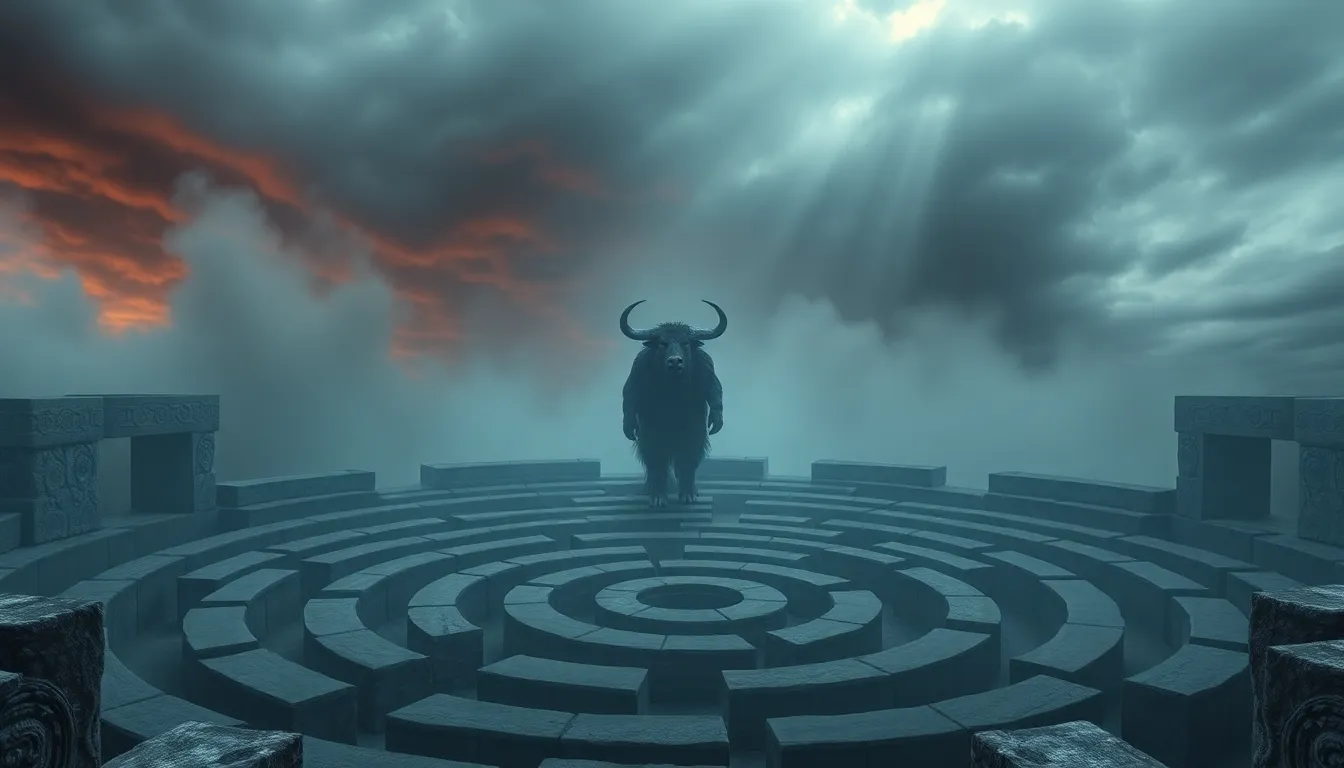The Minotaur and the Labyrinth: Symbolism of the Human Experience
I. Introduction
The tale of the Minotaur is one of the most enduring myths of Greek mythology, encapsulating profound themes of human nature and the journey of self-discovery. The Minotaur, a creature with the body of a man and the head of a bull, dwells within the intricate Labyrinth designed by Daedalus. This myth not only serves as a captivating story but also as a rich symbol of the human experience, embodying our struggles, fears, and the quest for meaning.
The Labyrinth, with its complex pathways and hidden perils, represents the myriad challenges we face throughout life. In this article, we will explore how the Minotaur and the Labyrinth serve as powerful metaphors for understanding our own experiences, decisions, and inner conflicts.
II. The Origins of the Minotaur Myth
The origins of the Minotaur myth can be traced back to ancient Crete, where it played a significant role in the cultural and religious life of the Minoan civilization. The myth not only reflects the fears and values of the society but also serves as an allegory for the battle between civilization and chaos.
Key characters in this myth include:
- The Minotaur: A monstrous offspring of Queen Pasiphaë and a sacred bull, symbolizing untamed primal instincts.
- Theseus: The heroic prince of Athens who seeks to confront the beast and liberate his people.
- Ariadne: Daughter of King Minos, who aids Theseus in navigating the Labyrinth.
The narrative arc of the Minotaur myth follows Theseus’s journey into the Labyrinth, where he confronts the beast and ultimately seeks to transcend the chaos it represents. This story resonates deeply within the human psyche, highlighting the struggle between our civilized selves and the more primal instincts that lurk beneath the surface.
III. The Labyrinth: A Complex Symbol
The Labyrinth is not merely a physical structure; it is a complex symbol with various interpretations. Characterized by its intricate pathways and potential for disorientation, the Labyrinth represents the challenges and dilemmas we encounter in life.
As a metaphor, the Labyrinth symbolizes:
- The confusion and uncertainty of life’s journey.
- The search for clarity and purpose amidst chaos.
- The intricate nature of human relationships and experiences.
Throughout cultures, the Labyrinth has been reinterpreted in various ways. For example:
- In ancient Rome, it symbolized the journey of the soul in the afterlife.
- In modern psychology, it represents the inner workings of the mind.
IV. The Minotaur: The Beast Within
Symbolically, the Minotaur represents the primal self—the raw, untamed aspects of human nature. This duality of the Minotaur encapsulates the struggle between civilization and savagery, reflecting the inner conflict we all face.
Key themes related to the Minotaur include:
- Primal Instincts: The Minotaur embodies instinctual drives that can lead to destruction if left unchecked.
- Inner Conflict: The Minotaur serves as a representation of our fears, desires, and the darker aspects of our psyche.
- Transformation: Confronting the Minotaur can lead to personal growth and transformation.
This psychological interpretation of the Minotaur highlights the importance of understanding and integrating our inner conflicts to achieve balance and wholeness.
V. The Journey of Theseus: A Hero’s Quest
Theseus’s journey into the Labyrinth embodies the archetype of the hero’s quest, a narrative pattern found throughout mythology and literature. This journey is not just about defeating the Minotaur; it is also about personal growth and self-discovery.
As Theseus navigates the Labyrinth, he faces numerous challenges that test his courage and resolve:
- Entering the Labyrinth symbolizes the willingness to confront one’s fears.
- Facing the Minotaur represents the confrontation of inner demons.
- Emerging victorious signifies personal transformation and empowerment.
Theseus’s journey emphasizes that personal transformation is a vital aspect of the human experience, encouraging individuals to confront their own challenges and emerge stronger.
VI. The Role of Ariadne: Guidance and Support
Ariadne plays a crucial role in Theseus’s journey, symbolizing intuition, guidance, and support. Her gift of the thread is a powerful metaphor for connection and hope, allowing Theseus to navigate the complexities of the Labyrinth.
Key aspects of Ariadne’s character include:
- Intuition: Ariadne represents the inner voice that guides us through difficult times.
- Support: Her assistance highlights the importance of mentorship and relationships in overcoming life’s challenges.
- Connection: The thread symbolizes the threads of connection we weave with others in our journey.
Ariadne’s role in the myth underscores the importance of support systems as we navigate our own Labyrinths, emphasizing that we need not face our challenges alone.
VII. Modern Interpretations and Relevance
In contemporary literature and art, the symbols of the Labyrinth and the Minotaur continue to resonate. They are often used to explore themes of identity, personal struggle, and the complexities of human relationships.
Psychologically, many individuals relate to the concept of navigating personal Labyrinths filled with uncertainties and challenges. The Minotaur serves as a reminder of the inner conflicts that must be addressed in order to achieve personal growth.
The enduring legacy of these symbols in modern society can be seen in:
- Literature that explores the journey of self-discovery.
- Art that reflects the complexity of human emotions and relationships.
- Psychological frameworks that encourage individuals to confront their fears and embrace their true selves.
VIII. Conclusion
In conclusion, the Minotaur and the Labyrinth serve as powerful symbols of the human experience, representing our struggles, fears, and the quest for meaning. As we reflect on these ancient myths, we recognize their ongoing relevance in understanding ourselves and navigating the complexities of life.
We are all on a journey through our own Labyrinths, facing our inner Minotaurs. By embracing these symbols, we can find guidance, confront our fears, and ultimately strive for transformation and wholeness in our lives.




